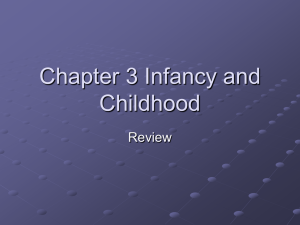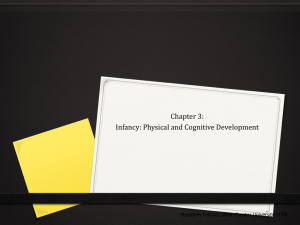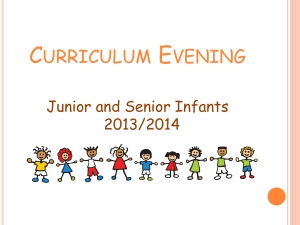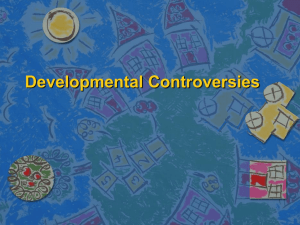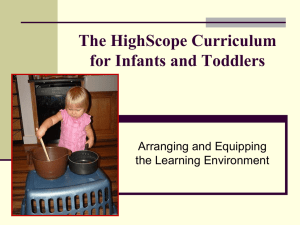CDfirst 2yearscognitvedevelopment
advertisement
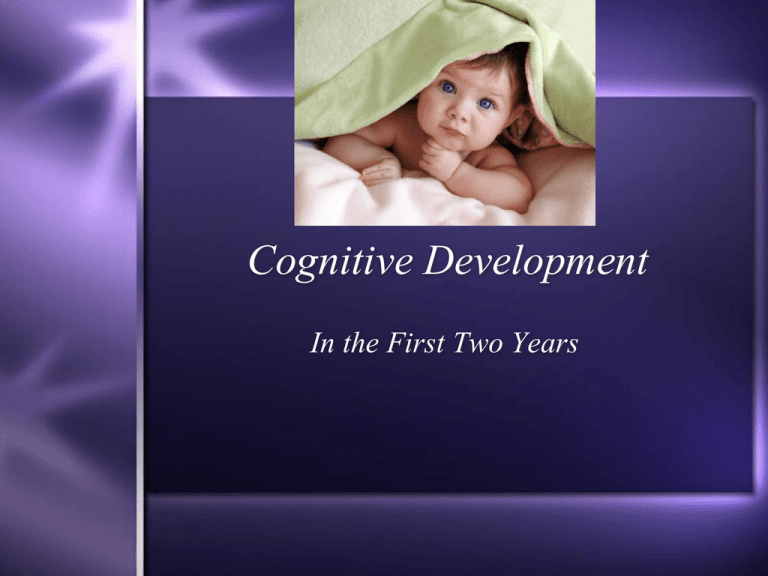
Cognitive Development In the First Two Years Jean Piaget: Period of Sensorimotor Intelligence Piaget (Swiss, 1896-1980) believed that infants were smart, active learners Also that they adapted to experience Called infancy (birth to 24 months) the sensorimotor period because infants learn through their senses and motor skills Period subdivided into 6 sub-stages Stages 1 & 2: Primary circular reactions The brain and senses interact involve the infant’s own body (birth to 1 month) Sensation, perception and cognition cycle back and forth (Piaget’s circular reaction) Stage 1: stage of reflexes--the reflexes of grasping, rooting, staring, listening-are adapted into deliberate actions Sensation becomes perception Stage 2 of Primary Circular Reactions: acquired adaptations Accommodation and coordination of reflexes (1-4 months) Example: sucking becomes adapted-infant sucks a pacifier differently than a nipple This indicates thinking: the infant has figured out that the pacifier is something different than a bottle Stages 3 & 4: Secondary Circular Reactions Involve the infant’s responses to objects and people Stage 3 (4-8 months) includes making interesting sights last: it is responding to people and objects, as in clapping hands when mother says “Patty-cake!” Also includes responding to toys The sight of something that delights the infant will trigger active efforts for interaction Stage 4 of Secondary Circular Reactions New adaptation and anticipation Infant becomes more deliberate and purposeful in responding to people and objects Example: putting other’s hands together in order to make her start playing pattycake Thinking is more innovative--babies are thinking about a goal and how to reach it Goal-directed behavior is a big deal This behavior stems from 1) an enhanced awareness of cause and effect 2) memory for actions already completed 3) understanding of other people’s intentions This new awareness coincides with new motor skills that are needed to achieve goals Object Permanence: Piaget thought babies attain this at 8 months Object permanence refers to the awareness that objects or people continue to exist even if they cannot be seen, touched or heard Probably occurs as early as 5 months, new research indicates it happens somewhere between 4 and 6 months Stages 5 & 6: Tertiary Circular Reactions Second year of life Feedback loops involve active exploration of the environment and experimentation “Little Scientists” in stage 5, (12-18 months) new means through active experimentation Examples: putting a teddy bear in the toilet and flushing, or squeezing all the toothpaste out of the tube Stage 6: New means through mental combinations (18-24 months) Considering before doing provides the child with new ways of achieving a goal without resorting to trial-and-error experiments This will hopefully involve remembering that flushing teddy down the toilet resulted in an overflowing toilet the last time it was tried Stage 6: Using mental combinations involves intellectual experimentation that supersedes active experimentation Children can now combine 2 ideas: they know a doll is not a real baby, but also that the doll can be belted into a stroller and taken for a walk They begin to think about consequences They also can defer imitation (copy behavior they saw hours or days before) Criticism of Piaget: Piaget underestimated infant cognition, probably because he based his ideas on observations of his own children, not of many children from many cultures Modern research includes “Habituation” or repeated exposure to get used to an object or event Then sensitive physiologic measurements are used to record reactions Using this, even 1-month-olds can be demonstrated to differentiate between sounds More criticism: The brain and its growth can now be measured by fMRI, which measures electrical activity in the brain that indicates firing of neurons This has shown us that the brain has a huge amount of early growth, then trims off dendrites Also shows that growth continues after the first 2 years Piaget didn’t have this technology Summing up Piaget: Piaget discovered that infants are very active learners Described this as Sensorimotor Period Substages: Circular Reactions Lacked modern technology Also used a restricted sample that may have led him to place some behaviors later than is true with the majority Information Processing Theory: A perspective that compares human thinking processes, by analogy, to computer analysis of data, including sensory input, connections, stored memories, and output Many versions of this theory All share the belief that a step-by-step description of the mechanisms of thought adds insight to our understanding How it works: Human information processing begins with input picked up by the senses It proceeds to brain reactions, connections, and stored memories It concludes with some output With the aid of technology, the information processing model has found impressive intellectual capabilities in infants, like a basic grasp of cause and effect by the middle of the first year Affordances: Opportunities for perception and interaction that are offered by a person, place, or environment Which particular affordance is perceived and acted upon depends on 4 factors: Sensory awareness Immediate motivation Current level of development Past experience Selective perception: Example: consider a lemon, an opportunity (an affordance) for smelling, touching, tasting, viewing, throwing, squeezing, and biting Further, each of these is an affordance for pleasure, pain, or some other emotional response Which affordance is perceived and acted upon is dependent upon sensations, motives, age, and experience How do they research this? Mostly by looking at what infants attend to on a TV screen Varies with age Varies with novelty Varies with experience Even varies with vocabulary Visual Cliff experiment: Tested depth perception An infant’s awareness was affected by experience, especially with falling Movement: Dynamic Perception Dynamic perception is perception that is primed to focus on movement and change Babies pay close attention to things that move and to people They also love to move: they grab, they scoot, they crawl, they walk And they realize that motion changes what the world affords them Dynamic Perception: Almost any moving creature will get the attention of an infant, who will chase and grab at it Even infants who are not mobile will try to catch a ball moving past them Experience affect this: younger babies may ignore slow-moving balls, but attempt to catch fast ones unsuccessfully, 20% or less success 9-month-olds know to reach for the slow moving balls, with an almost 100% success rate People Preference: Another universal principle of infant perception is that they are innately attracted to other humans, evident in visual, auditory, tactile, and other preferences In objects, infants prefer novelty In people, infants prefer familiarity They recognize their caregivers and expect certain affordances from them: comfort, food, entertainment) More on people preference: Infants can infer emotional affordances long before they understand language They “get” and respond to smiles, shouts, facial expressions, and tones of voice very early in life Studies indicate that 7-month-olds can reliably match facial expression and emotional tone of voice based on photos and tapes And even younger infants can do this with people they know Smiling and mommy and daddy: In these experiments, infants did not match the facial expressions and emotional voice of strangers, but could do so for their moms/dads, reacting swiftly and correctly The idea of researchers is that parents offer the affordance of JOY! Memory: Processing and remembering requires a certain amount of experience and brain maturation Even with repetition, infants have difficulty storing memories in their first year This is partly due to language deficits But infants do form memories--especially if motivated and if reminded repeatedly Experiments with mobiles and kicking indicate this Reminders and Repetition: Reminder session: a perceptual experience that is intended to help a person recollect an idea, a thing, or an experience, without testing whether the person remembers it at the moment Research employing these sessions demonstrated that even 3-month-olds could remember actions that they learned 2 weeks previously And it gets better: After 6 months, infants can retain information with less training, repetition and reminding By the end of the first year, many kinds of memory are apparent: deferred imitation by 9 months By 18 months, infants can remember and repeat complex sequences Toddlers action indicates conceptual thinking is present Child-directed speech: The high-pitched, simplified, and repetitive way adults speak to infants Fosters early language development By 7 months, infants begin to recognize words, but only words that are highly distinctive: bottle, dog, and mama are recognized before baby, Bobby, and Barbie Within the first few months of life, hearing becomes more selective, too What selective hearing means: They prefer child-directed speech They like alliterative sounds They love songs--rhyme, rhythm, and repetition And simple sounds more than complex sounds Infants respond to sounds they like (by 4 months) with squealing, growling, gurgling, grunting, crooning, and yelling Babbling: The extended repetition of certain syllables, such as ba-ba-ba, that begins when babies are between 6 and 9 months old Responses from other people encourage it It stops in deaf babies because they cannot hear responses Using sign language shows that babies can express language with gestures sooner than with speech First words: Usually at about 1 year Caregivers understand the baby’s words before strangers In the first months of the second year of life, vocabulary understanding is about 10 times the number of words they can say Holophrases: a single word spoken in such a way that expresses a complete, meaningful thought Naming Explosion: A sudden increase in an infant’s vocabulary, especially in the number of nouns, that begins at about 18 months of age In almost every language, the name of each significant caregiver, sibling, and sometimes, pet, is learned between 12-18 months of age Once the vocabulary reaches 50 words, it builds at a rate of 50-100 words per month 21 month olds say twice as many words as 18 month olds Cultural differences: Cultures and families vary a lot in how much child-directed speech children hear Some are more verbal than others Some cultures emphasize quiet children (not the US) And languages vary: some are VerbFriendly (verbs are placed before nouns) so infants learn as many verbs as nouns, unlike English Social context matters, too If social interaction is emphasized by the culture, verbs will be acquired as much as nouns Example: Chinese toddlers learn more verbs than US toddlers, who learn more nouns Ethnicities that speak the language of the country they have immigrated to have babies that learn language like the new culture Concepts and Language: Some concepts are easy, some are not In English, infants confuse before and after Dutch infants misuse out when it refers to taking off clothing Learning adjectives is easier in Italian and Spanish than in English or French because of the patterns in those languages Language: Conveys/encodes cultural values and social constructs If a child is more referential than expressive, it likely reflects the cultures, values, and priorities of the parents Putting words together: Grammar: all the methods--word order, verb forms, etc.--that languages use to communicate meaning, apart from the words themselves Grammar is obvious in 2-word sentences (baby cry, more juice), at about 21 months Grammar will correlate with the size of the child’s vocabulary, reflecting a knowledge of clear communication Learning more than one language can slow down language and grammar acquisition Theories of Language Learning: 50 years ago, the first theory reflected behaviorism (learning theory) and said that children needed to be taught language, step by step, through reinforcement This theory includes the ideas that parents/caregivers are expert teachers and help children speak Frequent repetition is instructive Well-taught infants become well-spoken children Studies in Behavioral Theory: Indicate great variation in how parents reinforce infants’ speech The frequency of paternal response at 9 months predicted infants language many months later Adults teach, infants learn language Theory 2: Infants teach themselves Noam Chomsky & followers believe that language is too complex to be learned through step-by-step conditioning Believe that because infants all master basic grammar at about the same age, there is a human mental structure that all are born with that prepares them to incorporate aspects of language Language Acquisition Device: Chomsky’s term for a hypothesized mental structure that enables humans to learn language, including the basic aspects of grammar, vocabulary, and intonation Enables children worldwide to derive the rules of grammar from the speech they hear everyday (whether English, Tamil, Urdu, Chinese, or Xhosa) This theory is accepted by many: Reflects the differences without ignoring language characteristics Reflects the fact that all languages are logical, coherent and systematic Believes that the brain expects language, and quickly and efficiently connects neurons to support whatever words an infant hears Works even with deaf infants who are taught signs Third Theory: Social impulses foster infant language learning Social-Pragmatic theory: says that neither behaviorism nor epigentic theory is correct--says that communication, the social reason for learning language, is most important Infants communicate because they are social beings dependent upon each other for survival, well-being, and joy Social newborn: Newborns seek out human faces By 9 months, infants’ brain patterns indicate attention when they hear people talk to them The emotional content, not the words, are most important in early communication Communication is the servant of social interaction Social toddler: Social impulses propel toddler language acquisition Toddlers learn language much more quickly from human interaction than from television, even though they watch TV Thus social language acquisition is more meaningful than simply learning words Hybrid theory: All three perspectives have merit Some of each theory has been demonstrated to work The important thing is that children are active learners, and that multiple factors are involved in learning language


